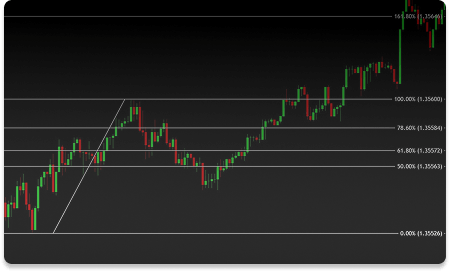Up to $5,000 Bonus this Black Friday


What is the Fibonacci Calculator?
The Fibonacci Calculator is a popular trading tool that helps traders identify potential support and resistance levels based on the Fibonacci sequence. To use it, traders enter a high and low price point, the market trend, and the calculator automatically generates retracement and Fibonacci extension levels.
These are key areas where price may pause, reverse, or accelerate. Based on the Fibonacci trading strategy, traders use these levels to plan entries, exits, and stop-loss placements, making it easier to anticipate market movements and improve trade timing.
Why Using the Fibonacci Calculator is Important?
Using a Fibonacci Calculator is important because it makes it easier for you to identify key price levels. Instead of manually calculating retracements and extensions, the tool, which can be used for all financial instruments, instantly shows you where the market might find support, resistance, or breakout zones. This not only saves time but also helps improve accuracy, giving traders clearer entry and exit points and stronger risk management.
Here are the key benefits of using the Fibonacci calculator:
Improve Accuracy
The calculator removes the need for manual math, giving you precise retracement and extension levels you can trust. Accurate levels mean more reliable trading decisions.
Save Time
Instead of plotting calculations by hand, the tool instantly delivers key price zones. This efficiency lets you focus on strategy and execution rather than number crunching.
Spot Key Market Levels
Fibonacci levels often align with areas where price reacts, such as support, resistance, or breakout zones. The calculator highlights these levels clearly, helping you anticipate market behavior.
Enhance Risk Management
By knowing where potential reversals may occur, you can set smarter stop-loss and take-profit points. This helps minimize losses while maximizing profit potential.
Gain Trading Confidence
Clear, data-backed levels take the guesswork out of trading. The calculator gives you a structured view of the market, boosting confidence in your entries and exits.
How to Use the Fibonacci Calculator
Using our Fibonacci Calculator is simple. Just enter a few key price points, and the tool instantly generates retracement and extension levels to guide your trading decisions.
Here's how to use our Fibonacci calculator:
Enter the High and Low Prices
Start by inputting the recent high and low of the price move you want to analyze, whether it is in a downtrend or an uptrend. These points form the basis for all Fibonacci calculations.
Add Custom Levels (Optional)
The calculator comes with standard Fibonacci ratios, but you can also enter custom levels if you prefer. This flexibility allows you to tailor the tool to your own trading style.
View Retracement Levels
Hit the calculate button, and the calculator will generate Fibonacci retracement levels (such as 38.2%, 50%, and 61.8%). These levels highlight potential support or resistance zones where price may pause or reverse during a pullback.
Explore Extension Levels
It also calculates Fibonacci extensions, which project possible price targets beyond the original high or low. Traders often use these to set profit targets in trending markets.
Apply to Your Trading Strategy
Use retracement levels to plan entries during corrections and extension levels to set realistic take-profit points. Combined, they give you a clearer roadmap of potential market movements.
FAQs
Read our frequently asked questions below. If you still need help, contact us today.
How to use the Fibonacci sequence in trading?
How can you calculate Fibonacci retracement levels?
What makes Fibonacci levels so popular in trading?
What is the best timeframe to use Fibonacci retracement levels?
More Free Tools Brought to you by Switch Markets
Explore benefits and free extras such as other financial calculators you can get if you open an account with Switch Markets.
Forex Profit Calculator
Calculate your profits and losses before or after executing a trade with our free Forex Profit Calculator.
Forex Lot Size Calculator
Use our simple yet powerful Forex Lot Size Calculator to calculate the exact position size for each trade and manage your risk per trade like a pro.
Forex Economic Calendar
Access our free economic calendar and explore key global events on the horizon that could subtly shift or substantially shake up the financial markets.
Currency Strength Meter
Compare the performance of major currencies relative to others in real-time with our advanced Currency Strength Meter.
Forex Swap Calculator
Calculate the swap rate for holding Forex positions overnight before you execute a trade with our free Forex Swap Rate Calculator.
Forex Compound Calculator
Use our Forex compound calculator and simulate the profits you might earn on your Forex trading account.
